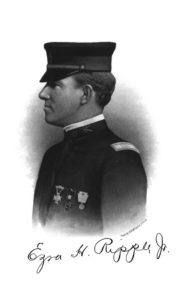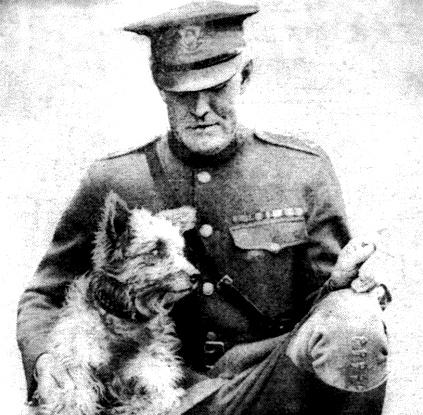Prior to the Spanish-American War, newspaper owners like William Randolph Hearst and Joseph Pulitzer, often sensationalized reports of Spanish atrocities against Cuban rebels. After the sinking of the Maine the national enthusiasm for war even extended to PMC. Although many cadets wanted to join the service, President Charles Hyatt convinced most to remain. While nearly seventy graduates responded to the call to service in 1898, two members of the senior class of 1898 also answered the call. Both Cadet Lieutenant Ezra H. Ripple, Jr. and Cadet Raymond W. Hardenbergh enlisted in the 13th Regiment of the Pennsylvania National Guard in May prior to Commencement. Although they both had left PMC and had entered the service, they received their degrees in civil engineering.
 Ezra H. Ripple enlisted as a private in Company D, and joined the regiment at Camp Hastings for training. At the time of muster, the 13th Pennsylvania consisted of thirty-six officers and 604 enlisted men. In May, the 13th Pennsylvania was ordered to Camp Alger, near Dunn Loring, Virginia, where it became part of the 2nd Army Corps, First Division. The 13th Pennsylvania remained in the new camp until August, when it was ordered back to Pennsylvania’s new Camp Meade, located near Middletown. Since the Spanish-American War ended on August 13, the 13th Pennsylvania did not see action.
Ezra H. Ripple enlisted as a private in Company D, and joined the regiment at Camp Hastings for training. At the time of muster, the 13th Pennsylvania consisted of thirty-six officers and 604 enlisted men. In May, the 13th Pennsylvania was ordered to Camp Alger, near Dunn Loring, Virginia, where it became part of the 2nd Army Corps, First Division. The 13th Pennsylvania remained in the new camp until August, when it was ordered back to Pennsylvania’s new Camp Meade, located near Middletown. Since the Spanish-American War ended on August 13, the 13th Pennsylvania did not see action.
Until 1900, Ripple was a mine surveyor, but decided to study law and entered the law department of the University of Pennsylvania and graduated in 1904. In 1905 he was admitted to the Lackawanna bar. In 1916 he commanded the 13th Pennsylvania during the Mexican Border Campaign. During World War I he was drafted into service and was attached to Headquarters, 55th Infantry Brigade, 28th Infantry Division.
Raymond W. Hardenberg enlisted as a private in Company E of the 13th Pennsylvania, and joined the regiment at Camp Hastings. From the 13th Pennsylvania he joined the Army Corps of Engineers under Col. Edgar Jadwin in Cuba and was appointed a Second Llieutenant in the regular army. He then participated in the Philippine Insurrection, and during World War I he served as brigade adjutant with the 159th Brigade, 80th Division A.E.F.
 Hardenberg is best known, however, as the trustee of “Rags”, the war dog and mascot of the 1st Infantry Division. Rags was a mixed breed terrier discovered in Paris by Sergeant James Donovan. He trained Rags to carry messages from the front lines to the 7th Field Artillery and Rags would return with a reply. Rags achieved great notoriety and celebrity when he saved many lives during the Meuse-Argonne Campaign by delivering a vital message despite being bombed, gassed and partially blinded. A severely wounded Donovan and Rags made their way back to the U.S. and Fort Sheridan, IL, where gas victims were being treated. In early 1919, Donovan died, but Rags soon became the post’s dog. The following year, Major Hardenbergh arrived at Fort Sheridan and the family soon adopted Rags. In 1924, Hardenbergh was transferred to Governor’s Island in New York Harbor, home of the 1st Division, with whom Rags had served in World War I. Rags soon became something of a celebrity in Manhattan. In 1934, Hardenbergh was transferred to the War Department. In 1936, Rags died. He was buried with full military honors and a monument to him was erected at the Aspen Hill memorial park and animal sanctuary in Silver Spring, Maryland.
Hardenberg is best known, however, as the trustee of “Rags”, the war dog and mascot of the 1st Infantry Division. Rags was a mixed breed terrier discovered in Paris by Sergeant James Donovan. He trained Rags to carry messages from the front lines to the 7th Field Artillery and Rags would return with a reply. Rags achieved great notoriety and celebrity when he saved many lives during the Meuse-Argonne Campaign by delivering a vital message despite being bombed, gassed and partially blinded. A severely wounded Donovan and Rags made their way back to the U.S. and Fort Sheridan, IL, where gas victims were being treated. In early 1919, Donovan died, but Rags soon became the post’s dog. The following year, Major Hardenbergh arrived at Fort Sheridan and the family soon adopted Rags. In 1924, Hardenbergh was transferred to Governor’s Island in New York Harbor, home of the 1st Division, with whom Rags had served in World War I. Rags soon became something of a celebrity in Manhattan. In 1934, Hardenbergh was transferred to the War Department. In 1936, Rags died. He was buried with full military honors and a monument to him was erected at the Aspen Hill memorial park and animal sanctuary in Silver Spring, Maryland.
Colonel Hardenbergh died on Feb. 3, 1949

